Wed, 26 March, 2025
TWI has been active in working with hydrogen since the 1950s, when we began investigating challenges around the hydrogen embrittlement of steels. Our hydrogen research and expertise has expanded in the ensuing decades to take in the effect of hydrogen on other materials, such as alloy steels and modern polymers.
As the requirements of our Industrial Members and wider industry itself expanded in relation to hydrogen, so we have grown our expertise and updated our facilities to meet these needs.
A History with Hydrogen
TWI’s history of working with hydrogen dates back to the 1950s, when we began to investigate hydrogen embrittlement in C-Mn (carbon and manganese) steels.
Hydrogen embrittlement can occur when hydrogen diffuses into a material; the greater the amount of hydrogen absorbed into the material microstructure, the greater the degree of embrittlement. When it occurs, hydrogen embrittlement can cause reduced ductility and a lessening of load-bearing capacity, leading to potential cracking and brittle failures below the anticipated proof or yield strength of the materials.
The 1950s also saw our experts turn their attention to stress corrosion cracking (SCC), which includes some specific mechanisms related to interaction with hydrogen, and sulphide stress cracking (SSC), where corrosion in environments containing hydrogen sulphide can cause hydrogen absorption and cracking.
Early investigations into hydrogen measurement in alloys began in the 1950s, but really grew at TWI during the 1960s, with investigations into the effect of hydrogen on alloy steels including stainless steels. Meanwhile, the investigations into C-Mn steels were developed into industry guidelines during the 1960s at TWI.
The development of a sour lab at TWI in the 1970s opened up capabilities for sour testing, which developed into the 1980s, where we developed sour service hardness guidelines of steel weld zones. The 1980s also saw TWI investigate the effect of hydrogen in Ni alloys and dissimilar joints, as we simultaneously continued to research sustained load cracking of Ti alloys.
Our work with hydrogen and various metals continued into the 2000s, as we also began to develop expertise and knowledge on hydrogen permeation in polymers. This new field of expertise coincided with improved understanding of hydrogen in dissimilar metal joints and the upgrading of our high pressure hydrogen capability.
TWI’s expertise looks set to be vital for sectors ranging from energy to transport, as hydrogen also emerges as a potential fuel source for industries including aerospace, automotive, rail, and space.
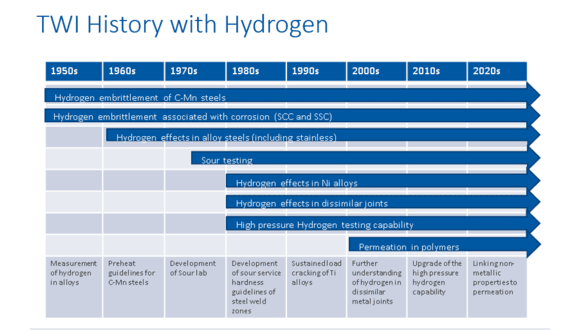
Materials in Hydrogen Infrastructure
If we are to realise the potential of hydrogen for industrial and public use, we will need to develop a robust hydrogen infrastructure, from production through distribution and end use.
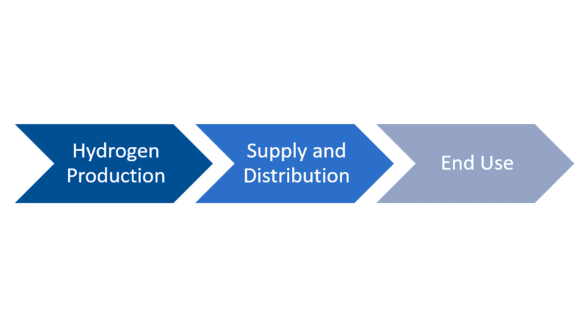
These materials include those used for mobile and large-scale hydrogen storage tanks, including filling stations, as well as the tubes and valves required for hydrogen transportation from production to end-use. There are also the materials used at the point of utilisation, such as hydrogen fuel cells.
Many of the material elements used in the hydrogen infrastructure are polymeric. High density polyethylenes, nylons, polyvinylidene fluorides and polyphenylene sulphides are used as liner materials while Teflon, PEEK, acetal, PFA, Buna-N, and Viton are commonly used as sealing materials in valves. These materials need to provide the required strength, ductility and fatigue resistance.
Hydrogen transport alone, as demonstrated by the table below, would include a wide range of components, applications and materials.
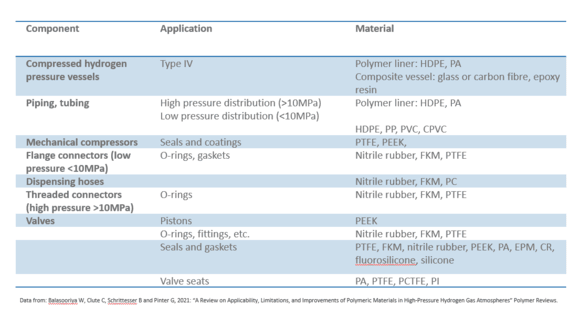
Materials used for hydrogen service need to be able to withstand both static and dynamic /cyclic exposure to hydrogen, which include operating temperatures as low as -70°C and as high as 120°C under high hydrogen pressure. The operating pressures required for hydrogen are normally between 5,000 and 10,000psi, but can reach as much as 15,000psi.
High-Pressure Hydrogen Service
For a safe hydrogen economy, it is essential to analyse the effect of hydrogen in combination with environmental and operational conditions such as temperature, pressure, humidity and weathering on pipelines, sealing materials and vessels. This will enable estimation and analysis of the material’s performance and provide understanding of its compatibility with hydrogen over a prolonged operational time.
The deeper understanding of material compatibility will allow industry to select appropriate materials and carry out bespoke testing and qualification of these materials, which will lead to improved performance, reliability, safety, and cost reduction.
Materials Challenges
Our testing services are designed to help counter a number of the different materials challenges related to durability and integrity management, including leakage, defect prediction and detection, hydrogen embrittlement, asset management, and the long-term effects of hydrogen service.
Example material challenges addressed at TWI include:
- Hydrogen embrittlement of steels
- Leakage through polymer pipes
- Leakage through joints
- Defect detection and identification
- Defect growth prediction
- Risk-based management
- Long term effects
Hydrogen Testing
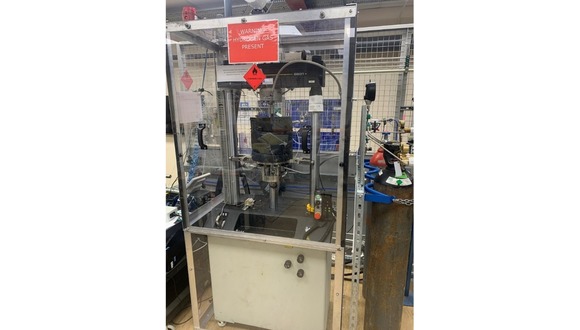
Our hydrogen testing facilities include a range of dedicated vessels capable of testing at 99.9999% purity H2 gas (testing of other gas mixes is also available). These vessels include capabilities to test from 175 bar (2,500psi) to 450 bar (6525psi) at ambient temperatures to 80°C within a 100kN load cell. We are also able to undertake in-situ direct current potential drop (DCPD) crack monitoring.
Hydrogen Mechanical Testing
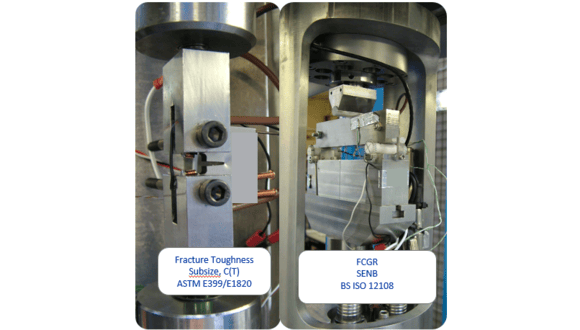
We can perform hydrogen mechanical testing in accordance with a range of standards. This testing includes bespoke testing services to suit the requirements of different industries and applications. Our mechanical testing services for hydrogen service include:
- Tensile
- Slow Strain Rate Tensile
- Fatigue Endurance
- Low Cycle Fatigue
- Fatigue Crack Growth Rate
- Fracture Toughness
The hydrogen damage mechanism is time dependent and linked to hydrogen outgassing after hydrogen exposure, which makes ex-situ measurements of mechanical properties problematic.
Meeting the Future Challenges of Hydrogen
The physical aspects of hydrogen service are just part of the challenge faced by industry, as there are also a number of gaps and barriers to widespread hydrogen use. These include:
- Largely inefficient existing standards for the specification of materials for hydrogen transport and storage
- Need to define environmental and stress limitations
- Assessments required for shortlisted polymer materials and composite systems
- Multiple parameter quantifications required
- Need for structure and weld qualification
- Need to reduce the cost of H2(g) testing (time-consuming and require special facilities)
- Requirements to stabilise the cost of converting ammonia back to hydrogen for consumption
The need for International Standards and Regulations
Currently, there are no recognised international standards addressing hydrogen production, transportation and responsible use. This is exacerbated by a lack of international regulations around hydrogen and ambiguity in the definitions of clean hydrogen and reliable, sustainable material requirements.
For example, the testing of tensile and bending properties of polymeric materials is outlined in the ISO 527 standard, ASTM D638 and ISO 178:2019. ASTM D618 provides the framework for conditioning plastic materials for testing in terms of temperature and humidity, but it does not include factors such as pressure or gas environment.
For hydrogen to realise its full potential, there is a paramount need for regulations and standards addressing safety in construction, maintenance, and operation – an area where TWI’s existing experience and expertise could prove pivotal.
Continuing Hydrogen-Related Development and Innovation at TWI
TWI has already been working to address some of the future challenges of hydrogen service through a number of projects.
We are currently running joint industry projects related to hydrogen service:
These joint industry projects (JIPs) bring together organisations with a mutual interest in the outcomes to share the cost of funding the work in return for exclusive access to the outcomes.
As well as the JIPs, we have completed two core research programme projects, funded by TWI Industrial Members, investigating:
- Thermoplastic materials compatibility in H2 service (project 34250)
- Long term behaviour of liner and coating materials in H2 service (35255)
In addition, we received funding from the European Space Agency (ESA) associated with the development of an elevated temperature hydrogen embrittlement rig at TWI.
To find out more about our expertise in hydrogen, please email contactus@twi.co.uk.